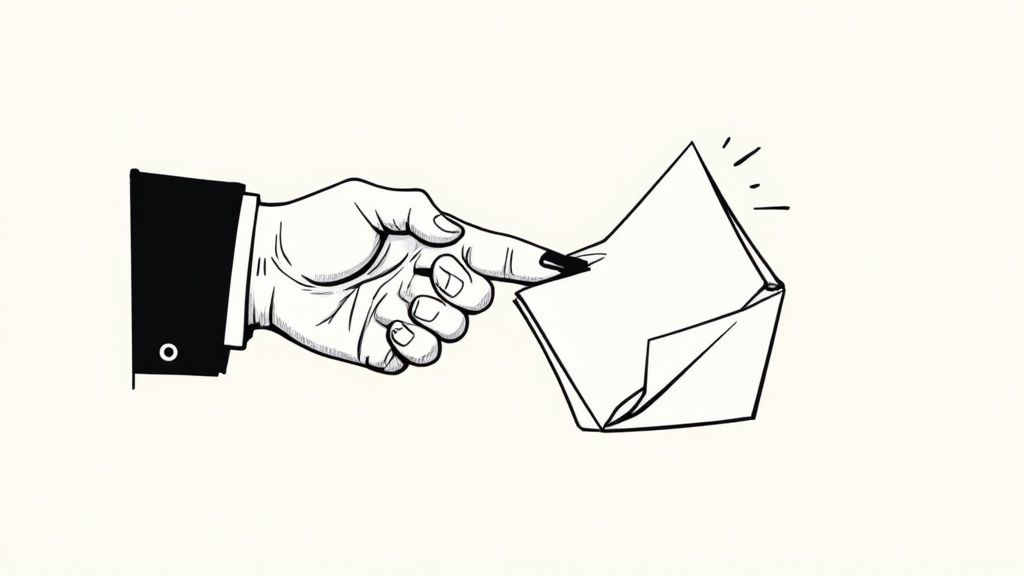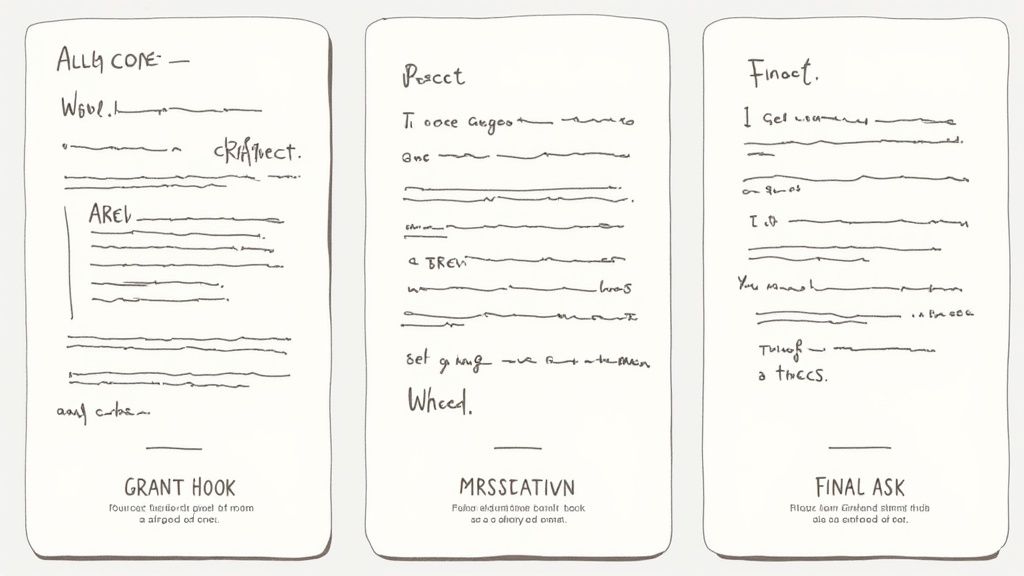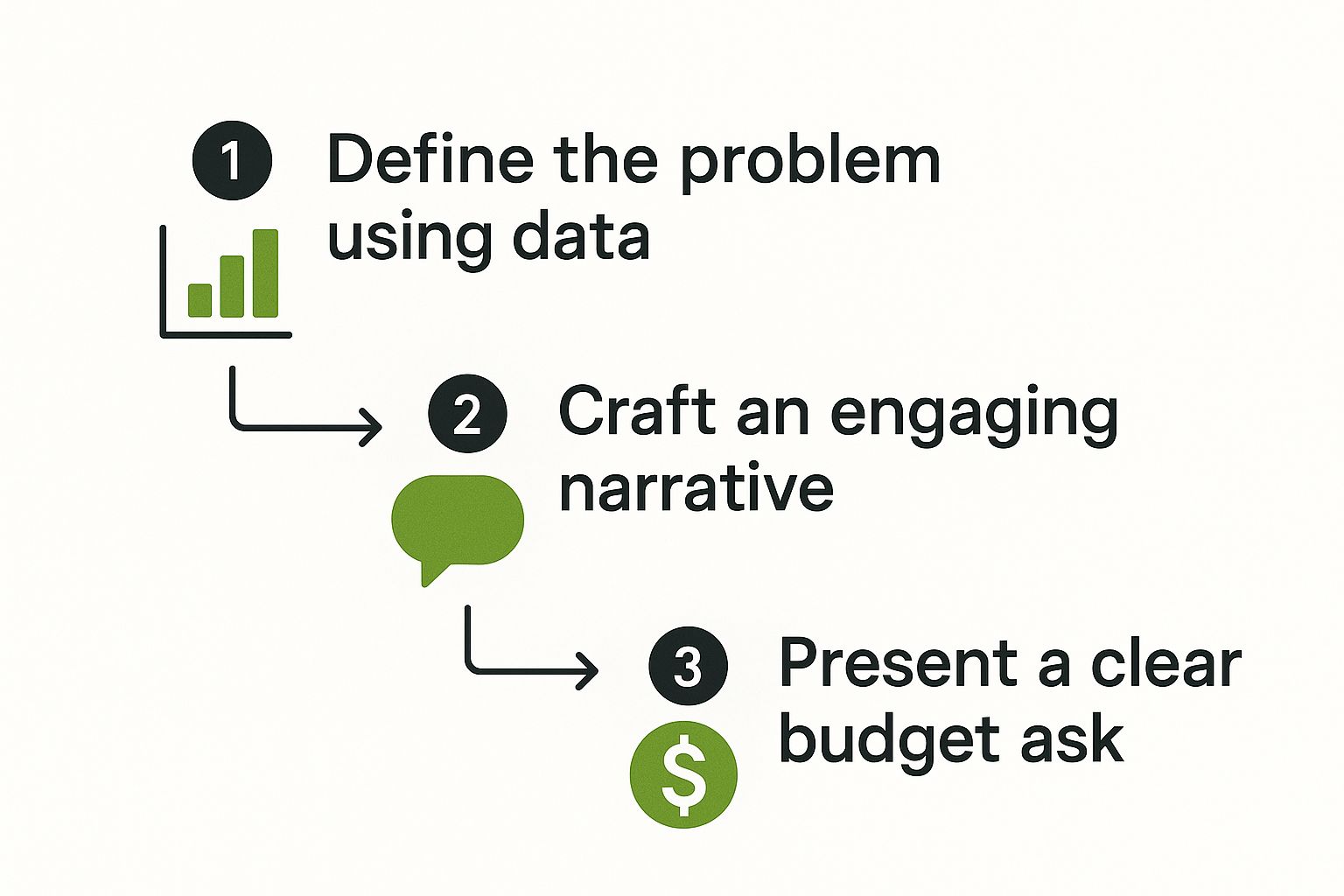A Winning Sample Grant Letter of Inquiry
Unlock funding with our expert sample grant letter of inquiry. This guide breaks down how to write an LOI that gets you noticed, with real examples and tips.

Before you ever dream of writing a full grant proposal, there’s a crucial first step that can make or break your funding chances: the letter of inquiry. Think of it as your strategic handshake. It’s that first introduction to a foundation, a concise pitch designed to show them your project is a perfect fit for their mission.
Getting this document right is absolutely essential for getting your foot in the door.
The Strategic Handshake That Secures Grant Funding

A Letter of Inquiry, or LOI, is basically your organization's audition. It’s a short, powerful document with a single, focused goal: to persuade a funder to invite you to submit a full grant proposal. This isn't just a brief summary of what you do; it's your first, best chance to build a connection and prove your work aligns with their goals.
Remember, foundations are absolutely swamped with requests. The LOI serves as their go-to filter, helping them quickly sift through countless applications to find the nonprofits that truly resonate with their mission. It saves everyone a massive amount of time and effort.
Why Your LOI Is So Critical
The statistics don't lie. A typical foundation might get hundreds of LOIs, but they'll only invite around 15–20% of applicants to move forward with a full proposal. That’s a tough cut, meaning 80–85% of inquiries are turned away right at the start, often because the alignment wasn't clear or the pitch just wasn't compelling enough.
That’s precisely why your LOI has to do more than just inform; it has to captivate. It needs to stand out from the pile by:
- Showing immediate mission alignment. The funder should see the connection between your work and their priorities within the first few sentences.
- Presenting a clear and urgent need. Use a mix of hard data and compelling storytelling to paint a picture of the problem you're solving.
- Demonstrating your credibility. Briefly showcase your organization's track record and what makes you uniquely qualified to address the issue.
A great LOI doesn't just ask for money. It invites a funder to become a partner in creating meaningful change, making it impossible for them to say no to learning more.
Ultimately, a sharp, well-written letter is the key that unlocks the door to deeper conversations and potential funding. Of course, before you can write a great LOI, you need to find the right opportunities. If you're still building your prospect list, check out our guide on how to find grants for nonprofits to get started.
A Look Inside a Winning Grant Letter of Inquiry

It’s one thing to talk about the theory behind a great letter of inquiry, but it’s another thing entirely to see one in action. Let’s get practical and break down a sample letter, piece by piece, so you can see the strategy behind the words.
Think of this less as a rigid template and more as a case study in persuasion. The goal is to see how a compelling story is built, one that perfectly aligns with a potential funder's mission.
First, Let's Set the Scene
To make this feel real, we need a scenario.
- Our Nonprofit: "Futures Forward," a group that runs coding bootcamps and provides job placement for unemployed young adults in the fictional city of Riverbend.
- Our Funder: "The Sparrow Foundation," a local foundation whose mission is to "foster economic mobility and create pathways to sustainable careers for underserved youth."
You can already see the connection, right? Futures Forward's work is a direct answer to The Sparrow Foundation's call. That synergy is exactly what you’re aiming for—it’s the foundation of a successful LOI.
The Sample Letter, Unpacked
Now, let's pull apart the sample letter and see what makes each section tick.
The Introduction: Hook and Alignment
Dear Ms. Evelyn Reed, Program Officer,
In Riverbend, over 3,000 young adults are currently unemployed, lacking the skills needed for today's tech-driven job market. Futures Forward is writing to The Sparrow Foundation today to request $25,000 to launch our "Code to Career" initiative, a program that directly supports your mission of creating pathways to sustainable careers for underserved youth by providing them with in-demand coding skills and direct job placement.
Why it’s so effective: This opening gets straight to the point without being blunt. It grabs attention with a local statistic (3,000 young adults) to show the problem is real and urgent. It states the ask ($25,000) right away, which funders appreciate.
But the most critical part? It uses the foundation’s own language back to them ("pathways to sustainable careers") to show this isn't a random shot in the dark—it's a perfect match.
The Problem: Creating Urgency with Data
The closure of the downtown manufacturing plant last year left a significant gap in our local economy, with youth unemployment spiking by 15%. These young people are motivated and eager to work but face a digital skills gap that locks them out of Riverbend’s growing tech sector. Without intervention, they risk falling into long-term unemployment, impacting not just their own futures but the economic health of our entire community.
Why it’s so effective: This section doesn’t just say "unemployment is a problem." It tells a story rooted in a specific local event (the plant closure) and backs it up with a hard number (a 15% spike). This makes the problem tangible.
It also smartly connects the issue to the broader community’s well-being, showing the funder their investment will have a much wider impact.
The Solution: Your Unique Approach
Our "Code to Career" initiative is a 12-week intensive coding bootcamp designed for 50 local young adults aged 18-24. Unlike traditional training programs, we partner directly with local tech companies like Innovate Solutions and TechCorp to shape our curriculum, ensuring graduates have the exact skills employers are hiring for right now. To date, our pilot program has achieved an 85% job placement rate within three months of graduation.
Why it’s so effective: Here, the solution is presented clearly. We know who it’s for (50 young adults) and what it is (a 12-week bootcamp). The letter then highlights the secret sauce—the partnerships with local companies that make the program different and more effective.
The final sentence is the knockout punch: an 85% job placement rate. This single metric proves the concept works and builds instant credibility. If you're just starting to piece these elements together, our complete guide on grant writing for beginners can give you a more foundational overview.
The Closing: A Confident Call to Action
With a $25,000 grant from The Sparrow Foundation, we can provide full scholarships for 10 more students, purchase necessary software licenses, and expand our job placement support. We are confident this partnership will advance our shared goal of fostering economic mobility in Riverbend. I have attached our organizational budget and a list of our board members for your review. I look forward to the possibility of discussing this exciting initiative with you further.
Why it’s so effective: This closing is all about confidence and clarity. It restates the $25,000 ask and shows exactly how the money will be used—this signals you have a solid plan.
It frames the grant as a "partnership" built on a "shared goal," which is collaborative, not just transactional. Mentioning the attachments shows you’re prepared and transparent. Finally, it ends on a positive and forward-looking note, making it easy for the funder to say "yes" to the next step.
Building Your Letter of Inquiry From Scratch
Staring at a blank page after reviewing a perfect sample LOI can feel a little daunting. The trick is to stop thinking of it as one big document and instead see it as a series of strategic building blocks. Each piece has a specific job to do, from hooking the reader right away to making a clear, confident ask.
Let's break down how to build your letter, step by step.
Your introduction is prime real estate. This isn't the place for a long, winding history of your nonprofit. You need to get straight to the point. In the first few sentences, hit them with the trifecta: the problem, your solution, and how much you need. This shows the program officer you respect their time and immediately puts your request into context.
Pinpoint the Problem with Hard Data
Funders get countless letters about "helping the community." That kind of vague language gets you nowhere. To make them sit up and pay attention, you need to prove the problem exists with cold, hard facts. You’re not just telling them there’s an issue; you're creating a sense of urgency.
- Go Local: How many families in your county are facing food insecurity? What’s the high school dropout rate in your specific service area? Local numbers hit harder.
- Show the Trend: Has the need for your services jumped in the last year? Citing a 20% increase in calls for assistance is much more powerful than a general statement.
- Connect the Dots: Did a major local employer shut down, leading to a spike in unemployment? Tying the problem to a real-world event makes it tangible and relatable.
When you ground your story in verifiable data, you transform your organization from just another applicant into a credible, informed expert ready to get to work.
Share Your Organization's Story
Once you've established the "why," it's time for the "who." This is your chance to introduce your organization, but skip the dry mission statement. Tell a quick, compelling story that proves you are the absolute best-equipped group to solve the problem you just laid out.
This is where you can drop a powerful statistic that builds instant credibility. Mentioning that your job training program has an 85% success rate in placing graduates or that you served over 500 homeless individuals last year speaks volumes. What makes you different? Do you have deep-rooted community partnerships or a proprietary method that gets results? Now’s the time to highlight that.
This simple infographic breaks down the core flow: use data to define the problem, build a compelling story around it, and then present a clear budget.

It really shows how a solid budget and an engaging narrative must be built on a foundation of data-driven proof that a community need exists.
Lay Out a Clear, Achievable Plan
Your solution can't just be a good idea; it has to be a concrete, actionable plan. I’ve seen so many otherwise good LOIs get rejected at this stage. Funders, especially those working to reduce inequality on wtgrantfoundation.org, need to see how you'll create change, not just that you want to. They're looking for that specific "lever" you're going to pull.
A strong LOI isn't just a funding request; it's an invitation to a partnership. You're asking the funder to join you in achieving a shared mission, which makes their investment feel more collaborative and meaningful.
Describe your project with absolute clarity. What are the key activities? Who are you serving? Most importantly, what are the expected outcomes? Be specific. Will you help 50 students improve their reading scores by one grade level? Answering these questions demonstrates that you’ve thought through the logistics and are ready to hit the ground running.
End With a Confident Ask
It's time to bring it all home. Your conclusion should be confident and direct. Reiterate your specific financial request and briefly touch on how the money will be put to work—a little transparency goes a long way.
Frame the ask not as a donation, but as a partnership that will help the funder achieve their goals, too. You’ll wrap up with a polite, professional call to action, letting them know you're eager to discuss the project in more detail. This leaves the door wide open for the next, crucial step: that coveted invitation to submit a full proposal.
Your Pre-Submission Quality Check

You've written a powerful letter, and that's a huge accomplishment. But whatever you do, don't hit "send" just yet. Rushing this final step is one of the most common—and costly—mistakes I see grant seekers make.
This last review is your quality control. It's the moment you transform a good draft into a polished document that gets noticed for all the right reasons. Think of it as that final 10% of effort that delivers 90% of the impact.
Perfect Your Funder Alignment
If there's one thing that gets an LOI rejected, it's poor alignment. Before you even think about proofreading, go back to the funder’s guidelines, their mission, and who they’ve funded recently. Does your project still feel like a perfect fit? I promise you, a program officer can spot a generic, copy-and-pasted letter from a mile away.
Make absolutely sure every piece of your letter is tailored to them:
- Speak Their Language: Do you echo any keywords or phrases from their mission statement? This shows you’ve done your homework.
- Connect to Their Priorities: Have you explicitly linked your project's results to the specific goals the foundation cares about?
- Check Their Giving History: Is your funding request in the same ballpark as what they typically award for similar work?
A quick search of their past awards can give you an incredible amount of insight. You can often find this by digging into a https://www.fundsprout.ai/resources/free-grant-database-for-nonprofits, which pulls together data on what foundations are actually funding.
Eliminate Every Single Error
Nothing torpedoes your credibility faster than a typo. A letter riddled with errors sends a subtle message: if you're careless here, you might be just as careless with your program management or financials.
This is where a fresh pair of eyes is non-negotiable.
Ask a colleague—or better yet, someone totally unfamiliar with your project—to read your letter out loud. It’s a simple trick that immediately highlights awkward phrasing and catches typos your own brain has learned to skip over. Double-check the small stuff, too. Getting the program officer's name, their title, or the foundation's name wrong is an instant red flag.
Rejection rates for LOIs can approach 80–90%. This isn't just because funders are selective; it's because so many letters are poorly aligned or written. A meticulous pre-submission check is your best defense against these common failure points.
That high rejection rate often gets misunderstood. Yes, only a fraction of foundations accept unsolicited proposals, but many rejections come from completely preventable issues. You can explore more about these statistics and learn about foundation giving trends on sparkthefiregrantwriting.com.
Navigate the Submission Process
Finally, read the submission instructions. Then read them again. Every funder has their own way of doing things, and ignoring their process is a surefire way to get your LOI tossed without a second glance.
- Does the funder want you to use an online portal?
- Should you send it as a PDF attachment in an email?
- Are there strict character or page limits you need to respect?
Following these rules shows you’re a professional who can follow directions—a crucial quality in any potential grantee. This final check ensures all your hard work actually gets the fair review it deserves.
Sidestepping Common LOI Blunders
Even a fantastic project can get tripped up by simple, avoidable mistakes in a letter of inquiry. Remember, a program officer might only give your letter a few minutes of their time. The last thing you want is to give them an easy reason to toss it in the "no" pile.
Honestly, learning to spot these common pitfalls is one of the fastest ways to get better results. Most errors come from forgetting what an LOI is really for: it's not just a request for money. It's the start of a professional relationship, showing a funder you get their mission and can be a solid partner in reaching their goals.
Ignoring the Funder's Instructions
This is, without a doubt, the number one reason LOIs get rejected. It's also the easiest one to fix.
Funders don't create guidelines for fun. When you ignore them—whether it’s the page limit, the requested font size, or specific questions they want answered—it screams that you can't follow directions. That’s a huge red flag.
The Fix: Before you type a single word, print out the funder’s guidelines. Get out a highlighter and mark up the key requirements. Treat it like a final exam checklist. If they ask for a two-page letter, do not send three. If they want a specific subject line for the email, use exactly that. This isn't just about ticking boxes; it's about showing respect and proving you're professional.
Relying on Vague Language and Jargon
Your LOI has to be sharp and to the point. Ditch the insider acronyms, academic jargon, and fuzzy statements like "we empower communities." The person reading your letter is likely sifting through dozens of others and just doesn't have time to decode what you're trying to say. When your language is muddy, your project seems unfocused.
For instance, instead of saying, "Our program addresses food insecurity," get specific: "Our program provides weekly fresh produce boxes to 50 families in the Northwood neighborhood, all of whom live more than a mile from a full-service grocery store."
A heartwarming story might hook a small individual donor, but a foundation considering a $50,000 investment needs to see clear, data-driven proof of impact. They simply can't fund ambiguity.
See the difference? Specificity turns a vague concept into a real, measurable project.
Making It All About You, Not Them
This is a classic rookie mistake. The letter becomes all about your organization's internal needs. "We need a new van" or "We need to fund a staff position" are your problems, not the funder's. Funders want to invest in solutions that impact the community, not just your operational budget.
The Fix: You have to reframe every single request around the community benefit. Instead of, "We need $10,000 for a new van," try this: "A $10,000 investment will allow us to purchase a refrigerated van, enabling us to deliver 500 additional meals per week to homebound seniors."
This simple tweak shifts the narrative from your internal problem to the community-based solution you're offering—which is what the funder actually cares about. By dodging these common missteps, your sample grant letter of inquiry will be cleaner, more compelling, and far more likely to land in the "yes" pile.
Your Top Questions About Grant LOIs, Answered
Even for seasoned grant writers, the Letter of Inquiry can bring up a few tricky questions. I've heard them all over the years, so let's walk through some of the most common ones.
The sweet spot for an LOI is almost always one to three pages. If you go shorter, you're likely missing crucial details that paint the full picture. Any longer, and you're testing the patience of a busy program officer.
Of course, the funder's guidelines are the ultimate authority here. If they specify a page count, stick to it without question.
Is it Okay to Contact the Foundation Before Submitting?
This is the big one, and my answer is a firm "it depends." Many foundations are crystal clear on their websites, stating "no calls" or "no unsolicited contact." If you see that, respect their process.
But what if there’s no warning? A quick, strategic call can be a fantastic move. Just don't call to ask something you could have found on their "About Us" page.
Use that brief conversation to:
- Briefly introduce your organization and your project's core idea.
- Confirm you're on the right track with their current funding priorities.
- Put a human voice to the name they'll soon see in their inbox.
Making that small personal connection can make your letter pop out from the stack. It shows initiative and a genuine interest in partnership.
A rejection isn't a failure—it's feedback. It’s valuable data you can use to refine your project, sharpen your story, and find an even better funding match next time.
My LOI Was Rejected. Now What?
It stings, I know. But rejection is a normal part of the grant-seeking cycle. If the foundation was kind enough to offer feedback, treat it like gold. Those notes are a direct roadmap for how to improve.
If you just get a form letter, it's okay to send one polite, brief email. Ask if they might be willing to share any insights that could help with future submissions. Some will, some won't.
Either way, take this as a chance to critically review your sample grant letter of inquiry. Did you tell a compelling story? Was the budget clear? This experience is just fuel for making your next application even stronger.
Accelerate your entire grant lifecycle with Fundsprout. Our AI-powered platform helps you find perfectly matched funders, draft compelling narratives, manage deadlines, and simplify reporting, so you can focus on your mission, not the paperwork. Discover how Fundsprout can secure your next grant.
Try 14 days free
Get started with Fundsprout so you can focus on what really matters.
